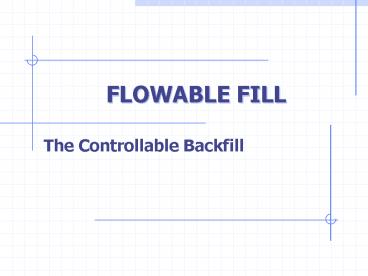FLOWABLE FILL
1 / 26
Title: FLOWABLE FILL
1
FLOWABLE FILL
- The Controllable Backfill
2
WHAT IS FLOWABLE FILL?
- DEFINITION - Flowable Fill is a self compacting,
cementitious material used primarily as a
backfill material in lieu of compacted-soil
backfill. - Defined in ACI 229R-94.
3
Other Terms for Flowable Fill
- CLSM - Controlled Low Strength Material
- CDF - Controlled Density Fill
- Flowable compacting fill
- Lean fill
- Ready mixed flowable fill
- Flow fill
4
What Is a Flowable Fill Mix?
- Main Ingredients
- Cement
- Sand
- Water
- with
- Fly Ash
- GGBF Slag
- Stable Air Generators
5
Properties of Flowable Fill
- High Slump
- (9 /-)
- Low Strength
- Commonly 100 PSI (0.7 Mpa) in 28 days
6
Flowable Fill is NOT Concrete
- Similarity ends with delivery vehicle
- Low cementitious
- Does not hydrate
- Settles, dewaters
- The wetter the better
- Less water does not equate to faster hardening
- Too little water will not allow proper settlement
7
Therefore . . .
- Specification offers
- Flexibility of design
- Minimal mix design testing
- Little or no field testing required
8
Typical Flowable Fill Mixes
- Standard Type
- Portland Cement 35
- Fly Ash 300 400
- Sand 2600 (/-)
- Water 415 460
- Air 6
- optional
- Air Generated
- Portland Cement 80
- Sand 2400
- Water 295
- Air (design) 30
9
PennDOT Specification Section 220
Bottom Ash or Coarse Agg or Fine Agg or Air
Generating Admixture
10
Compacted-Soil Backfill Concerns
- LACK OF COMPACTION -- Causes most call-backs to
repair settlement problems. - Improper backfill is the number one complaint of
public works directors. - How to Get Utilities to Repair Streets Right,
Better Roads, April,
1990 - Study indicates that 65 of utility cut
restorations were unsatisfactory. - Utility Cut Restoration, Metropolitan Toronto
Roads And Traffic Department, April 1985
11
Other Concerns
- Compaction around pipes for support.
- Number of compaction lifts
- Increases project construction time.
- Continuous testing.
- Requires continuous inspection.
- Safety of workers.
- Moisture content.
- Storage of materials on site.
- Inconsistent soil test results.
12
Benefits of Flowable Fill
- Reduced in-place costs
- less labor equipment
- Minimized settlement
- Easily removable
- Durable
- Versatile
13
Benefits of Flowable Fill
- Year-round availability
- No compaction required
- Self leveling
- Increased worker safety
- Can Be color-coded for utility identification
14
Single-pass filling of voids speeds project
15
Flowable Fill Saves Money
- Labor Costs for Placing Granular Backfill
- Placement 73.98
- (2 laborers _at_ 36.99/hr)
- Compaction 73.98
- (2 laborers _at_ 36.99/hr)
- Heavy Equip. Operator 40.33
- Hand Compactor 15.00
- Backhoe 25.00
- Total labor for granular fill 228.30
National Industry Average incl. overhead costs
16
Flowable Fill Saves Money
- Labor Costs for Placing Flowable Fill
- Placement
36.99 - Compaction
n/a - Heavy Equipment _n/a_
- Total labor for Flowable Fill 36.99
- Total labor for Granular Fill 228.30
- Labor savings
181.31
17
Flowable Fill Applications
- Backfill
- Structural Fill
- Other Uses
18
Flowable Fill as Backfill
- Where speed of construction is advantageous and
where better performance is required. - Ideal for use in tight or restricted areas where
placing soil fill is difficult. - Trenches utilities, primarily under
roadways - Bridge abutments
- Pipe bedding
- Building excavations
- Wet conditions
19
Flowable Fill as Structural Fill
- Road base
- Mud jacking
- Sub footing
- Floor slab base
20
Other Uses for Flowable Fill
- Abandoned sewers, tanks, pipe, etc.
- Environmental remediation
- Slope stabilization
21
Typical Areas Which are Difficult to Compact
Underground Tanks Foundation Wall
Backfilling
- Road Cuts
- Under Around Pipes
22
Fast Track Fill and Pave
- Backfill trench with CLSM to 4 below street
level. - Place a concrete overlay of 4000 PSI (28 Mpa)
concrete pavement.
23
CLSM IS EXCAVATABLE WITH CONVENTIONAL EQUIPMENT
- 100 PSI CLSM can be excavated with backhoe
- Can also be dug with pick and shovel
24
Where Can I Get Flowable Fill?
- From Your Local Ready Mix Producer
25
IN CONCLUSION
- For better quality construction,
- consider using
- FLOWABLE FILL
- on your next project.
26
For Further Information
- Contact
- Pennsylvania Concrete Promotion
Council 800-251-0616 - www.paconcrete.com































